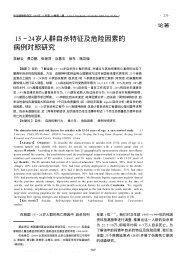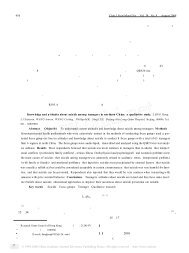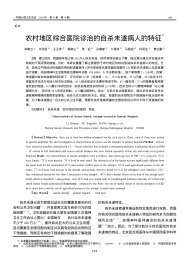Attitudes Toward Suicide Among Chinese People in Hong Kong
Attitudes Toward Suicide Among Chinese People in Hong Kong
Attitudes Toward Suicide Among Chinese People in Hong Kong
You also want an ePaper? Increase the reach of your titles
YUMPU automatically turns print PDFs into web optimized ePapers that Google loves.
566 <strong>Attitudes</strong> <strong>Toward</strong> <strong>Suicide</strong> <strong>in</strong> <strong>Hong</strong> <strong>Kong</strong><br />
Ch<strong>in</strong>a [HKSAR], 2004; Census and Statistics <strong>Ch<strong>in</strong>ese</strong> subjects (Phillips, 2004). This ver-<br />
Department of HKSAR, 2004).<br />
sion of the CASQ was then adapted for the<br />
Published research on suicide and at- present study after another round of n<strong>in</strong>e fotempted<br />
suicide <strong>in</strong> <strong>Hong</strong> <strong>Kong</strong> has focused cus groups conducted among <strong>Ch<strong>in</strong>ese</strong> sub-<br />
on the analysis of trends, methods of suicide, jects <strong>in</strong> <strong>Hong</strong> <strong>Kong</strong>.<br />
risk factors, and its association with mental With written <strong>in</strong>formed consent, n<strong>in</strong>e<br />
disorders (Centre for <strong>Suicide</strong> Research and focus groups with a total of 82 participants<br />
Prevention, 2005). The f<strong>in</strong>d<strong>in</strong>gs of these stud- (41 males and 41 females) were conducted <strong>in</strong><br />
ies are usually derived from a quantitative <strong>Hong</strong> <strong>Kong</strong> <strong>in</strong> a quiet group room of a<br />
analysis of cl<strong>in</strong>ical or population data and university department from April 13 to June<br />
provide an <strong>in</strong>formative epidemiological pro- 7, 2002. Six of the groups consisted of people<br />
file of suicide. Nonetheless, they have limited of different age categories (namely, 15–19,<br />
explanatory power with regard to the cultural 20–26, 27–38, 39–50, 51–65 and 66 years or<br />
mean<strong>in</strong>gs of suicide among <strong>Ch<strong>in</strong>ese</strong> people above, respectively). The other three groups<br />
(Hsieh & Spence, 1981; Lee & Kle<strong>in</strong>man, were composed of suicide attempters, health-<br />
2005; Wolf, 1975).<br />
care professionals, and policy-related per-<br />
Cultural mean<strong>in</strong>gs are l<strong>in</strong>ked to social sonnel.<br />
attitudes. S<strong>in</strong>ce <strong>in</strong>dividuals draw upon cul- Dur<strong>in</strong>g the focus groups, we used<br />
tural representations of suicide when they open-ended questions to probe participants’<br />
contemplate, attempt, or commit suicide, perception of such issues as what suicide was,<br />
study<strong>in</strong>g public attitudes toward suicide may why it happened, how common it was, what<br />
help us elucidate the causes and patterns of k<strong>in</strong>d of people it affected, how it <strong>in</strong>fluenced<br />
suicide <strong>in</strong> a community (Lee & Kle<strong>in</strong>man, others, and what could be done to prevent it.<br />
2005). Attitud<strong>in</strong>al research may also shed We then presented 13 scenarios of fatal and<br />
light on theories of suicide <strong>in</strong> general. To nonfatal suicides to the participants. The sce-<br />
date, no systematic study of <strong>Ch<strong>in</strong>ese</strong> attitudes narios were about problems aris<strong>in</strong>g from love<br />
toward suicide has been carried out <strong>in</strong> <strong>Hong</strong> relationships, chronic psychiatric illness, <strong>in</strong>-<br />
<strong>Kong</strong> or ma<strong>in</strong>land Ch<strong>in</strong>a. Thus, the authors law oppression, domestic violence, haunt<strong>in</strong>g<br />
(from <strong>Hong</strong> <strong>Kong</strong>, Beij<strong>in</strong>g, and Boston, MA, by ghosts, nonfilial children, repeated failures<br />
respectively) carried out a collaborative proj- <strong>in</strong> a college entry exam<strong>in</strong>ation, parental disect<br />
that comb<strong>in</strong>ed qualitative and quantita- approval of marriage, bus<strong>in</strong>ess failure, alcotive<br />
methods to assess attitudes toward suihol/gambl<strong>in</strong>g, unexpla<strong>in</strong>ed depression, tercide<br />
<strong>in</strong> several communities <strong>in</strong> Ch<strong>in</strong>a m<strong>in</strong>al cancer, and impulsive wrist-slash<strong>in</strong>g<br />
<strong>in</strong>clud<strong>in</strong>g <strong>Hong</strong> <strong>Kong</strong>. The present paper re- related to loss of face. Each focus group<br />
ports the f<strong>in</strong>d<strong>in</strong>gs from <strong>Hong</strong> <strong>Kong</strong>. lasted 2 hours. The sessions were taperecorded,<br />
transcribed, and analyzed us<strong>in</strong>g the QSR<br />
Nvivo text analysis software. From the ma<strong>in</strong><br />
themes the <strong>in</strong>vestigators derived by listen<strong>in</strong>g<br />
METHOD to the tapes, the text analysis created n<strong>in</strong>e<br />
Instrument<br />
primary nodes for content organization.<br />
These <strong>in</strong>cluded a general impression about<br />
suicide <strong>in</strong> society, personal attitudes toward<br />
The <strong>Ch<strong>in</strong>ese</strong> Attitude <strong>Toward</strong> <strong>Suicide</strong> suicide, methods used, reasons for suicide,<br />
Questionnaire (CASQ) was generated on the perception of impulsivity, acceptance of sui-<br />
basis of text analysis (us<strong>in</strong>g QSR Nvivo softcide, and the consequence and prevention of<br />
ware) of 101 focus groups and 18 <strong>in</strong>-depth suicide. Subbranches of the content were <strong>in</strong><strong>in</strong>terviews<br />
conducted by the ma<strong>in</strong>land aucluded <strong>in</strong> each node and the number of octhors<br />
(LX, MP). It was revised after two sub- currences was counted for each subbranch.<br />
sequent pilot tests of the prelim<strong>in</strong>ary scales Additional questions were derived from each<br />
<strong>in</strong> approximately 2,000 randomly selected subbranch that occurred frequently.<br />
492
















